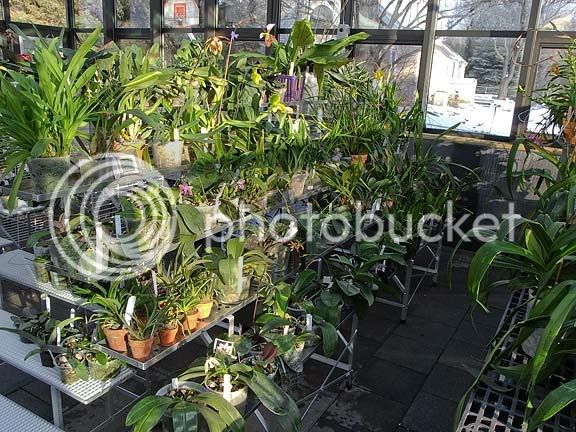John M
Orchid Addict
Dot, I love, love, love, love, love, love your greenhouse floor!!!!!!!! My greenhouse floor is earth and it's muddy! Yuck! I've put down lots of limestone screenings in the aisles; but, eventually, the mud oozes up through the tiny stones and the aisle gets disgusting again. A nice floor is the single biggest thing I'd like to change about my greenhouse. I must wear boots in there. I even keep spare pairs of rubber boots handy for guests if they arrive soon after watering. It's a pain and it looks horrible.
Until now, I was unaware of all the various options one has to consider when deciding how to manage the automatic operation of greenhouse heaters. In my case, I have two heaters. Each one is 175,000 BTU's and is enough to handle the heating for the greenhouse on it's own. One is a back-up to the other. Each heater has two simple, rugged thermostats situated on a pannel just above the bench in the middle of the greenhouse. One is set for the day temp I want and the other is set for the night temp that I want. Both run off a heavy duty, mechanical timer that is wired in-line on the North wall next to the electrical pannel. I set the time for day temps and night temps that I wanted by sliding a pointer and tightening a screw. Since I set them 19 years ago, I've never wanted to change them. When the timer flips to "on" (about 8:30 p.m.), the nighttime thermostat is the one controlling the heater. When the timer flips to "off" (about 7 a.m.), the daytime thermostat becomes the one controlling the heater. It's a system that has worked beautifully for me for over 19 years. Want pictures?
BTW: I think I prefer the basic, old fashioned mechanical thermostats and timers. Electronic, digital stuff can be fried by a utility power surge or even a single lightning strike. Because they are wired in and not something that you can "unplug", like a microwave or TV, there is always a chance that a rogue power surge could shut down everything until you get an electician in there to replace the electronics. By then, your plants are either fried by the heat or frozen by the cold. Of course, these disasters happen only during the coldest and hotest times of year, on Sundays! Over the years, I've had to replace a computer modem, a microwave, a VCR and an answering machine because of lightning strikes on the power grid; but, never any components in my greenhouse......except the electronic, vairable speed, circulator fan control. Of course, I learned my lesson and put the household electronics on surge protectors; but, the greenhouse stuff is direct wired. So, I'm glad that it's all the old fashioned, basic, mechanical type of controls that are not effected by surges.
Until now, I was unaware of all the various options one has to consider when deciding how to manage the automatic operation of greenhouse heaters. In my case, I have two heaters. Each one is 175,000 BTU's and is enough to handle the heating for the greenhouse on it's own. One is a back-up to the other. Each heater has two simple, rugged thermostats situated on a pannel just above the bench in the middle of the greenhouse. One is set for the day temp I want and the other is set for the night temp that I want. Both run off a heavy duty, mechanical timer that is wired in-line on the North wall next to the electrical pannel. I set the time for day temps and night temps that I wanted by sliding a pointer and tightening a screw. Since I set them 19 years ago, I've never wanted to change them. When the timer flips to "on" (about 8:30 p.m.), the nighttime thermostat is the one controlling the heater. When the timer flips to "off" (about 7 a.m.), the daytime thermostat becomes the one controlling the heater. It's a system that has worked beautifully for me for over 19 years. Want pictures?
BTW: I think I prefer the basic, old fashioned mechanical thermostats and timers. Electronic, digital stuff can be fried by a utility power surge or even a single lightning strike. Because they are wired in and not something that you can "unplug", like a microwave or TV, there is always a chance that a rogue power surge could shut down everything until you get an electician in there to replace the electronics. By then, your plants are either fried by the heat or frozen by the cold. Of course, these disasters happen only during the coldest and hotest times of year, on Sundays! Over the years, I've had to replace a computer modem, a microwave, a VCR and an answering machine because of lightning strikes on the power grid; but, never any components in my greenhouse......except the electronic, vairable speed, circulator fan control. Of course, I learned my lesson and put the household electronics on surge protectors; but, the greenhouse stuff is direct wired. So, I'm glad that it's all the old fashioned, basic, mechanical type of controls that are not effected by surges.













































